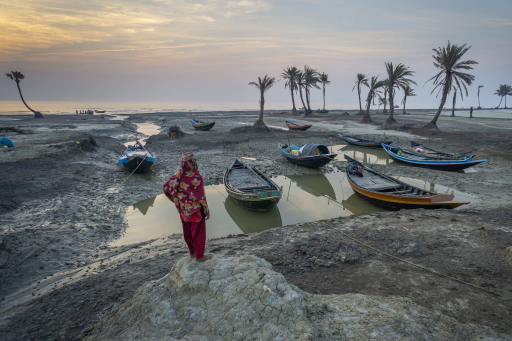2 The power of photography
Many of our most powerful encounters with climate change are through photographs. Photography is uniquely suited to addressing climate crisis-related issues, combining realism with the use of visual devices that can enhance the emotional impact of an image. Educators across all sectors and subject areas can harness the power of photography when addressing the climate emergency in teaching and learning activities, with the potential to increase learner engagement and provide opportunities for creativity and personal expression. In this section you’ll explore some such possibilities.
In their article ‘The power of photography as we enter ‘code red for humanity’ [Tip: hold Ctrl and click a link to open it in a new tab. (Hide tip)] ’, Greenpeace International Content Editor Tan Lee Kuen (2021) identifies photography’s role in addressing the climate crisis:
There is no denying the power of photography as a universal medium of communication, one that transcends language and cultural barriers. And the planet needs everyone on board in the fight against climate change…Through images, we can see the planet’s vulnerable beauty as well as the devastating impact of our actions and what we could potentially lose without immediate, direct action.

Photography can support climate change-related awareness-raising and understanding, together with climate action, in many different ways, some of which are more appropriate than others for specific educational sectors, contexts and disciplines. For example, photography can:
Raise awareness of what we stand to lose as a consequence of climate change, and also give a visual record of species before they become extinct. National Geographic photographer Joel Sartore’s Photo Ark project is intended to do just this. The Photo Ark currently features 44,947 pictures recording 13,907 species (at the time of writing in 2023).
Raise awareness of the human impact of climate change. This, in turn, can be particularly relevant in teaching addressing climate justice. Gavin Bell (2021), writing for the Royal Photographic Society’s journal, asserts that ‘science can explain the causes and effects of climate change, but it takes photography to graphically illustrate its human cost’. An online interactive by UN Women is just one example, using photography to show how the impact of climate change is greatest for the world’s poorest people, especially women and girls.
The Iranian photographer Solmaz Daryani also works in this way. She was shortlisted in the 2020 Royal Photographic Society (RPS) Science Photographer of the Year competition for her images showing the human impact of dust storms and flash floods in Afghanistan. Her series The Eyes of Earth: The Death of Lake Urmia, 2014 also shows the catastrophic impact of climate change on humans and the environment, with images of parched agricultural land, abandoned tourist resorts and dilapidated pleasure boats stranded far from the shrinking waters. The RPS 2020 exhibition gives further examples of how photography can show the effects of climate change and the ways in which we are working to reverse them.
Act as a catalyst for conversations. This function of photography has particular relevance for use in educational settings, especially in the context of online, blended and technology-enhanced teaching where access to impactful images should be straightforward. Sudhanshu Malhotra, Greenpeace Multimedia Editor, comments:
‘The role of photography is to start a conversation so that people can start talking about what is happening and wanting to know more. It has the ability to create a chain reaction. A strong image can stay long in our memories and has a strong recall value. It stays with us.’ (Kuen, 2021)
Increase the ways in which students of all ages can get involved in climate crisis-related activism and awareness-raising, especially now that most mobile phones are equipped with cameras. Drones and action cameras can add to the range of perspectives. Whatever your subject area, supporting students in taking climate crisis-related photos, and in using them to raise awareness and drive change, can be a valuable endeavour, especially as many young people will already be familiar with the process of sharing images through social media platforms such as Instagram. There are many resources available to support students’ photography skills, for example:
- The Royal Photographic Society Science & Photography resources for educators have some suggestions about how science and photography can complement each other.
- The Climate Visuals: Seven principles for visual climate change communication (based on international social research) report offers guidance about strategies that can help ensure climate-related images are effective.
- Marie Gardiner (2019) offers some useful advice in her article ‘Picturing Climate Change: How to Photograph your Environment’.
- Friends of the Earth’s ‘How to take good photos and videos’ page has some good basic tips, with a focus on campaigning.
